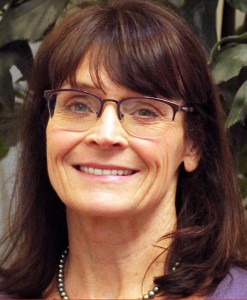

Family Meals Focus
The Ellyn Satter Institute Newsletter
Countywide obesity prevention – speaking with one voice
By Carol Danaher, MPH, RD
The health service providers in Santa Clara County, CA, give consistent feeding messages and work together on behalf of parents, thanks to the Childhood Feeding Collaborative. The intervention for families and organizational partners alike is Satter’s division of responsibility in feeding.
The toddler was severely anemic and overweight and there were family issues
Consider the experience of this Santa Clara County mother and daughter, a high-risk family who received consistent and best practice feeding guidance from Childhood Feeding Collaborative (CFC). During a routine visit to the pediatrician, the 2-year-old girl was found to be so severely anemic that mother and daughter were sent to the hospital’s Emergency Department for a possible blood transfusion to quickly raise the girl’s hemoglobin level. The mother reported that the girl ate daily only ice cream, ½ gallon of milk, and candy. The admitting pediatrician, a Childhood Feeding Collaborative (CFC) partner, recognized that a list of high iron foods would be insufficient to help this parent improve the child’s diet, so she referred the parent to the CFC’s “5 Keys to raising a healthy, happy eater” parenting class to learn how to feed according to Satter’s division of responsibility in feeding (sDOR). Because the girl was also overweight, her family was referred to the Santa Clara County child overweight treatment program. There, the parent received a feeding intervention and follow-up with a Registered Dietitian who taught sDOR. Family issues that emerged during that intervention were addressed by a Santa Clara County Public Health Nurse who did home visits. The nurse was trained in sDOR so she could address feeding issues based on sDOR.
Santa Clara County, CA does sDOR-consistent cross-disciplinary intervention
No organization acting alone, regardless of its influence or size, can effectively change community norms on child feeding. CFC maximizes effectiveness of change by coordinating feeding communication among all relevant service providers.
How did we get to this point? Since 2007, Childhood Feeding Collaborative of Santa Clara County, CA Public Health Department has received grant funds to reduce known risk factors for child obesity by improving feeding practices in early childhood. The intervention for families and organizational partners alike is Satter’s division of responsibility in feeding. CFC is made up of partners that serve families with young children across a continuum of services – primary healthcare, obesity treatment, health plans, public health programs, childcare programs, and community organizations. None of these organizations acting alone, regardless of its influence or size, can effectively change community norms on child feeding. CFC maximizes effectiveness of change by coordinating feeding communication among all relevant service providers. The service providers use different approaches to applying sDOR based upon the nature of their program or activities. Impressive parent and pediatrician evaluations indicate we are meeting our goals.
What Santa Clara County does to build and maintain Childhood Feeding Collaborative
The work began in 2002 with members of a child health and fitness coalition. Collaboration was the starting point, and continues to drive our grant proposals and scope of work. The elements of our success are the result of CFC members who:
- Articulate a shared vision: “Improve parenting skills around feeding at the earliest opportunity to reduce known risk factors for obesity.” CFC partners target their sDOR-consistent feeding interventions to families with children beginning with the age at which solids are introduced (4 to 6 months) through to the preschool years. These interventions provide coordinated and consistent messaging with Santa Clara County’s breastfeeding promotion programming; Head Start and childcare providers’ Child and Adult Care Food Program feeding standards; pediatricians’ routine feeding guidance during well child exams; and WIC nutritionists’ group and individual visits.
- Train and build skills in the Satter Feeding Dynamics Model and the division of responsibility in feeding: Success depends on partners’ having a high degree of competency in the sDOR. Without this, families receive a confusion of messages. We use grant funds to contract with the Ellyn Satter Institute (ESI) to provide periodic and well-targeted trainings. Our evaluations show that the ESI trainings result in knowledgeable and confident feeding educators and interventionists. To sustain CFC’s vision, I and other highly trained professionals also provide periodic trainings on sDOR to different audiences, such as physicians, Public Health Nurses, childcare providers and consultants, and Social Service and mental health providers.
- Build upon existing community assets: Each CFC partner has assets or strengths that support the shared vision. For example, health plan partners sponsor CFC training events for pediatricians and offer the “5 Keys to Raising a Healthy, Happy Eater” parenting class as a member benefit. The 5 Keys are the 5 sDOR domains: parents’ what, when, where of feeding and the child’s how much and whether of eating.
- Focus intervention for highest impact: All CFC partners focus their activities on the period of early childhood during which the parent is learning how to feed and the child is developing eating attitudes and behaviors.
- Are responsive to local funder’s priorities for systemic change: Local funding organizations often work together to maximize the impact of their grants. CFC is sensitive to shared funding strategies for initiatives directed at reducing child obesity; preventing dental caries; or promoting healthy eating active living. CFC grant proposals consider the funder’s over-arching social change priorities.
Explore
ESI Board Chairman and faculty member Carol Danaher
To view a recorded webinar, Speaking with One Voice, Satter’s Division of Responsibility-Based (sDOR), County-Wide Intervention with Child Obesity, click here.
More by Carol Danaher
- Family meals Focus: Celebrate National Family Day with a family dinner
- Family Meals Focus: Pureed food in pouches: boon or bane?
- USDA FNS child feeding policies and recommendations: what is the role for the division of responsibility in feeding?

